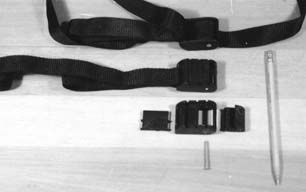
Whether lashing the dinghy on the foredeck for a bit of offshore work; tying off the kids’ sailboard along the rail, or securing a barbecue grill on the stern deck, keeping things lashed down on a boat can be difficult. No matter how many nice pieces of small stuff you use as tie-downs, somehow, after a few thousand cycles, the stuff works loose. Then it starts chewing on itself—and other stuff. Seasoned voyagers know, getting it tight—and keeping it tight—is more difficult than it would seem.
The historically-classic tiedown for a heavy load is the Trucker’s Hitch, also known as a Waggoner’s Knot. The first stage of the knot is called a Bellringer’s Knot. Other variants go by names like Highwayman’s Hitch, Harness Loop, Farmer’s Loop and, to manage those tents, circus folks had one called a Wet Weather Hitch.
Somewhere along history’s timeline, somebody came up with belts and buckles. But their Achilles’ heel is that they all permit some of that troublesome slack mentioned above, or, when tightened down, they’re very difficult to release.
Now, a new idea, invented in a Pennsylvania city called King of Prussia, whose 18,000-odd souls prefer that you not call it a suburb of Philadelphia. Maybe W.C. Fields was right when, on passing a graveyard, he commented, “All things considered, it’s better than Philadelphia.” (Fields was born there, but ran away from home at age 11.)
The invention is called a Load Lock FASTener®. In 2003, it won a prestigious award at the National Hardware Show.
It’s simple—no snaps, no springs, no hooks—just three carbon fiber castings (one of them quite complex, the other quite precise) and a 1/8″ solid stainless pin. The castings look good and the sewing on the webbing, either polypropylene or nylon versions, is excellent.
The secret is a double-edged rocker cam that pivots on the pin. In the open position, which the cam assumes naturally when being assembled or tightened, the one-inch-wide webbing moves freely. With a load, the cam clamps down in two places within the buckle.
What makes the patented Load Lock different is that it can be adjusted under load, within limits. It’s done by applying thumb pressure to the cam, which pivots it into the open position. The movement in the trailing edge of the cam is about 1/8″.

The easy-to-adjust, cam-action lock makes it easy to eliminate slack in the webbing—tightening it or easing it as needed. From open to full lockdown, there is but 5/32″ play.
PS tested the Load Lock, firstly to determine how easy it is to tighten and slack the webbing, and secondly to see how much tension it would take before breaking. Because webbing is very strong (1″ polypropylene will take about 500 lbs., 1″ nylon goes about 1,500 lbs., and tubular nylon about 3,500 lbs.), PS suspected the buckle would fail first.
With repeated tests with three different Load Locks at 20, 40, 50 and 60 lbs., we demonstrated that the easing can be done easily at up to 40 lbs., with moderate finger pressure. At 50 lbs., depressing the cam to ease the web is more difficult, but still within average finger pressure. At 60 lbs., the easing tested the limits of human thumb pressure and the release was sudden and noisy. It was a warning to not tighten these straps too severely. Better to use three or more than to overstress one.
Some Load Lock models, made of glass-filled nylon, have a breaking strength of 230 lbs. Black polycarbonate models are said to withstand more than 300 lbs. Using a winch and the arrangement shown in the photo, PS pumped four of them up to 300 pounds; none broke or appeared altered.
Load Locks will serve well as battery and gas can tiedowns; lashings for on-deck equipment; as sail ties; for hanging electrical cords, or to hoist a dinghy. Perhaps best of all, they will make ideal straps to keep taut a bimini top, awning, or dodger.
A very simple but brilliant (and no-cost) addition to Load Locks was the inclusion of a web loop where the webbing is sewn to the buckle. It makes adjustment easier. Further, one can encircle a heavy sail bundle with a couple of Load Locks and carry it with the loops.
Load Locks come with different lengths of webbing, in different colors and in sets, including a “Roof Rack in a Sack,” which has two Load Locks, several sets of straps and two slotted foam blocks, for car-top usage. The prices range from $5.95 for a battery tie-down set, to $54.95 for a “Dinghy/RIB Lift.”
Contact – DRD Corp., 610/239-0650, www.loadlockfastener.com.







































